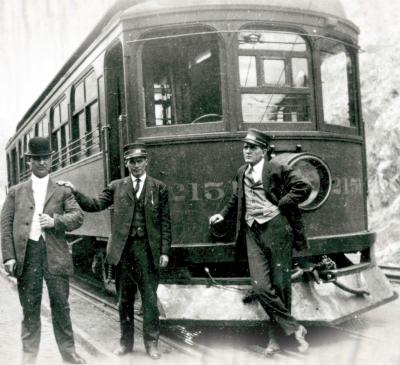Deadwood Trolley History
A Brief History of Deadwood's Trolley System
Deadwood's public trolley system, established in 1992, provides visitors a way to enjoy the scenic beauty of Deadwood Gulch. This interurban system is not a new concept, but rather one that was well rooted in Deadwood 's history. Twelve years after Deadwood's incorporation, two separate interurban systems, the Deadwood Street Railroad (1888-1893) and the Deadwood Central Railroad (1888-1924), once traveled the streets of Deadwood.
Deadwood Street Railroad 1888 - 1893
The Deadwood Street Railroad was incorporated in August of 1888 and consisted of three horse-drawn street cars manufactured by the J.G. Brill Company of Philadelphia, Pennsylvania. It took two teams of horses to pull a trolley along the set of rails embedded in the center of Lee, Main, Sherman, and Charles Streets for a total distance of one and one-half miles. After five years of service, the Deadwood Street Railroad was dismantled in 1893 due to the lack of patronage.
Deadwood Central Railroad 1888 - 1924
In 1888, The Deadwood Central Railroad was also incorporated, however, it was not functional until the following year. A 34,000 pound H.K. Porter steam locomotive was used to pull two passenger cars along a narrow gauge railroad line that connected the cities of Deadwood and Lead (present day US Highway 85). The initial route was 3.33 miles in length and gained 600 feet of elevation. Within its first year of operation, the Deadwood Central Railroad traveled an estimated 72,000 miles between the cities, carried approximately 29,000 passengers and generated over $7,000 in fares.
In 1901, the locomotive was replaced by three electric trolley cars numbered 12150, 12151, and 12152. Each electric trolley was powered by two 660-volt electric motors. Energy used to power the trolleys came from a substation located at the base of McGovern Hill near the present-day Mickelson Trailhead. At its height, the electric trolleys made 14 roundtrips daily, operated from 6:15 a.m. to 12:30 a.m. six days a week, and took fifteen minutes to make the run in either direction. An additional .64 miles of track was added which expanded the route to its maximum length of 3.97 miles.
By 1924, the electric trolley line was abandoned due to the advent and use of the automobile. Two of the three electric trolleys remained in the cities of Lead and Deadwood and were converted into dining cafes. Sixty-eight years would elapse before Deadwood’s streets would see another public trolley system.
Deadwood Trolley 1992 - Present
Beginning in 1992 , the Deadwood Historic Preservation Commission and City of Deadwood purchased six gasoline powered trolleys. Each trolley is powered by a Triton V-10 engine and drives on average 25,000 miles per year shuttling over 250,000 riders. The Deadwood Trolleys are also used in parades, tours, and the "Trolley on the Trails" program, which allows disabled individuals the opportunity to access the Mickelson Trail free of charge.

